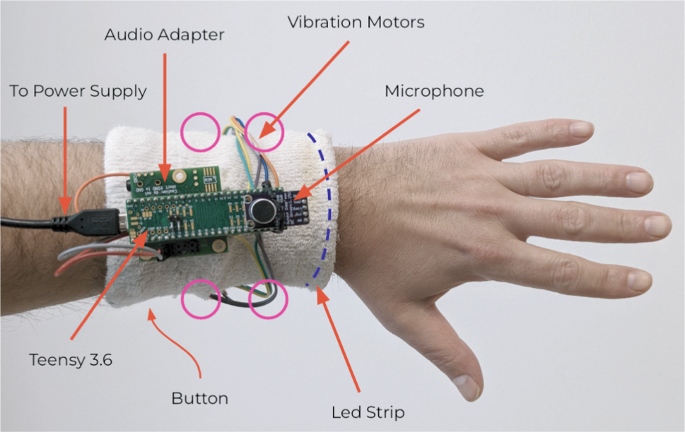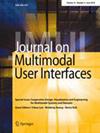Hearing loss prevention at loud music events via real-time visuo-haptic feedback
IF 2.1
3区 计算机科学
Q3 COMPUTER SCIENCE, ARTIFICIAL INTELLIGENCE
引用次数: 0
Abstract
Abstract Hearing loss is becoming a global problem, partly as a consequence of exposure to loud music. People may be unaware about the harmful sound levels and consequent damages caused by loud music at venues such as discotheques or festivals. Earplugs are effective in reducing the risk of noise-induced hearing loss but have been shown to be an insufficient prevention strategy. Thus, when it is not possible to lower the volume of the sound source, a viable solution to the problem is to relocate to quieter locations from time to time. In this context, this study introduces a bracelet device with the goal of warning users when the music sound level is too loud in their specific location, via haptic, visual or visuo-haptic feedback. The bracelet embeds a microphone, a microcontroller, an LED strip and four vibration motors. We performed a user study where thirteen participants were asked to react to the three kinds of feedback during a simulated disco club event where the volume of music pieces varied to reach a loud intensity. Results showed that participants never missed the above threshold notification via all types of feedback, but visual feedback led to the slowest reaction times and was deemed the least effective. In line with the findings reported in the hearing loss prevention literature, the perceived usefulness of the proposed device was highly dependent on participants’ subjective approach to the topic of hearing risks at loud music events as well as their willingness to take action regarding its prevention. Ultimately, our study shows how technology, no matter how effective, may not be able to cope with these kinds of cultural issues concerning hearing loss prevention. Educational strategies may represent a more effective solution to the real problem of changing people’s attitudes and motivations to want to protect their hearing.

通过实时视觉触觉反馈预防大声音乐活动中的听力损失
听力损失正在成为一个全球性的问题,部分原因是暴露在嘈杂的音乐中。人们可能没有意识到在迪斯科舞厅或节日等场所嘈杂的音乐所造成的有害声音水平和随之而来的损害。耳塞在降低噪音引起的听力损失的风险方面是有效的,但已被证明是一种不充分的预防策略。因此,当无法降低声源的音量时,一个可行的解决方案是不时地搬迁到更安静的地方。在此背景下,本研究介绍了一种手环设备,其目的是通过触觉、视觉或视触觉反馈,在用户特定位置的音乐声级过大时警告用户。这款手环内嵌了一个麦克风、一个微控制器、一个LED灯条和四个振动马达。我们进行了一项用户研究,要求13名参与者在模拟的迪斯科俱乐部活动中对三种反馈做出反应,其中音乐作品的音量变化到一个响亮的强度。结果显示,通过所有类型的反馈,参与者从未错过上述阈值通知,但视觉反馈导致的反应时间最慢,被认为是最无效的。与听力损失预防文献报道的结果一致,所提议设备的感知有用性高度依赖于参与者对大声音乐活动中听力风险主题的主观方法以及他们采取预防措施的意愿。最终,我们的研究表明,无论技术多么有效,都可能无法应对与听力损失预防有关的这些文化问题。对于改变人们保护听力的态度和动机这一实际问题,教育策略可能是一种更有效的解决方案。
本文章由计算机程序翻译,如有差异,请以英文原文为准。
求助全文
约1分钟内获得全文
求助全文
来源期刊

Journal on Multimodal User Interfaces
COMPUTER SCIENCE, ARTIFICIAL INTELLIGENCE-COMPUTER SCIENCE, CYBERNETICS
CiteScore
6.90
自引率
3.40%
发文量
12
审稿时长
>12 weeks
期刊介绍:
The Journal of Multimodal User Interfaces publishes work in the design, implementation and evaluation of multimodal interfaces. Research in the domain of multimodal interaction is by its very essence a multidisciplinary area involving several fields including signal processing, human-machine interaction, computer science, cognitive science and ergonomics. This journal focuses on multimodal interfaces involving advanced modalities, several modalities and their fusion, user-centric design, usability and architectural considerations. Use cases and descriptions of specific application areas are welcome including for example e-learning, assistance, serious games, affective and social computing, interaction with avatars and robots.
 求助内容:
求助内容: 应助结果提醒方式:
应助结果提醒方式:


